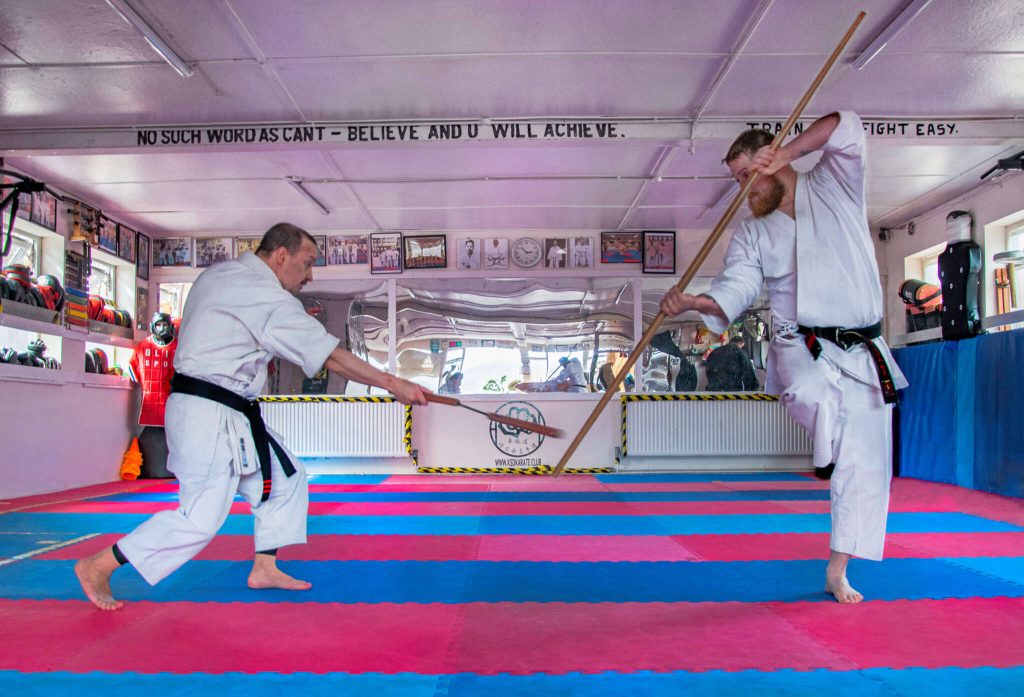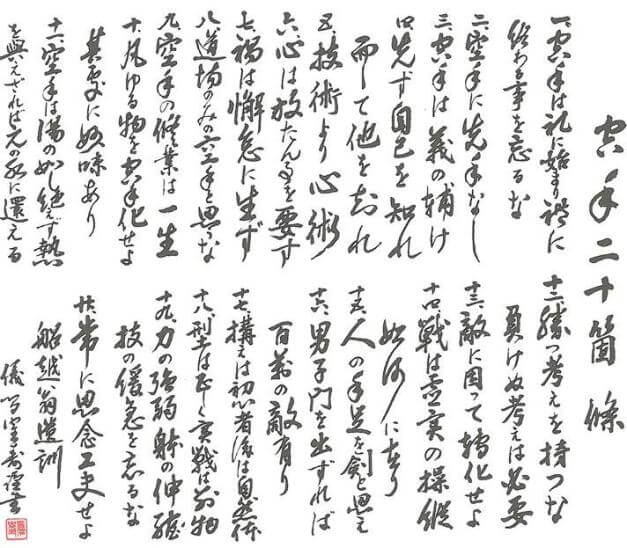Our style of karate is Shukokai Karate, a branch of Shito-Ryu Karate.
Karate-Do (Kara – Te – Do) simply means “empty hand way”:
- Kara = Empty
- Te = Hand
- Do = Way

Karate is made up from three K’s, they are:
Our classes are made up of the Ken Shu Dojo eight E’s:
- Enthusiasm
- Engaging
- Energy
- Explosiveness
- Enjoyable
- Educational
- Empowering
- Excellence
Funokoshi Sensei’s 20 guiding principles of karate-do

1. Do not forget that karate-do begins, and ends, with rei.
You must show respect to all other karateka whilst in the dojo. You should bow at the beginning and end of every session, and with every opponent. You should also bow when entering, or leaving, the dojo. Simply bowing is not showing respect, or rei. Rei is much more than that, the Japanese think of rei as being that which provides order, which separates man from animal.
2 . There is no first strike in karate.
A karateka must endure to the limits of his ability before taking direct physical action. Bushido (the martial way) teaches a samurai to draw his sword only at the last possible moment in the worst possible scenario. A karateka will NEVER instigate violence or perpetuate it’s development. Only, as a last resort, will a karateka use his skill to end a fight.
3. Karate stands on the side of justice.
A practitioner of karate must always seek the side of justice and, if necessary, defend it. To witness injustice and do nothing is to show a lack of courage.
4 . First know yourself, then know others.
‘When one knows the enemy and knows oneself, one will not be in danger in a hundred battles. When one is ignorant of the enemy yet knows oneself, chances of victory or defeat are even. When one knows neither the enemy nor himself, each and every battle will surely be perilous.’
5. Mentality over technique.
This principle is important because karate is not simply about performing techniques correctly (if it was, it would be a dance). Of greater importance to your ability is your attitude, your spirit and your awareness. You must have the attitude of perseverance, the spirit of strength and the awareness of focus. Train with intensity and feel what you are doing.
6. The mind must be set free.
You must release your mind from restriction and restraint. A free mind has the ability to roam and travel to wherever it wants to go. This freedom of movement will provide greater understanding of yourself and karate. Beginners are often reluctant to release themselves, fearing what might happen if they do.
7. Calamity springs from carelessness.
Careless preparation or negligence can result in mistakes being made with disastrous consequences. Take the time to think about what you are doing and analyse yourself to eradicate these mistakes.
8. Karate goes beyond the dojo.
The ultimate aim of karate-do is not simply to become a proficient martial artist. Karate teaches us many things and cultivates our mind, as well as our body. We should be thinking as a karateka in our everyday life and the values and lessons we learn in the dojo should be taken out into the outside world.
9. Karate is a life long pursuit.
Karate is an endless road of training and dedication. Nobody has ever reached the end of their training and nobody ever will. The reason is because there is no end. You must be prepared to train in karate for the rest of your life, because thats how long it will take.
10. Apply the way of karate to all things. Therein lies it’s beauty.
Karate teaches that in combat, a single blow can be fatal. If you approach all challenges in life with the same serious attitude, you will find that there is little you cannot overcome.
11. Karate is like boiling water, without heat it returns to it’s tepid state.
You must continually and regularly train because if you do not, then like the pan of boiling water, your karate will go cold.
12. Do not think of winning. Think, rather, of not losing.
To seek only to win is to ignore the true nature of karate. Those who wish only to win will become obsessed with this goal at the expense of all around them. Such a person will lose their humility and will seek any advantage at any cost. Instead, you should consider ensuring that you do not lose. As to be defeated could mean your life.
13 & 14. Make adjustments according to your opponent. The outcome of a battle depends on how one handles emptiness and fullness.
Bruce Lee, one of the greatest martial artists who ever lived, was often quoted saying that you must act like water. Water has no form and can mould itself to any terrain. Like water, you must adjust and change to your opponent, be fluid and unpredictable. Avoid your opponents strength and attack his weaknesses.
15. Think of the opponent’s hands and feet as swords.
A skilled and practised fighter can fatally wound an opponent with a single blow from their hands and feet. Therefore, they are as deadly as a sword. Even an untrained man, fighting for his life, can deliver a powerful and deadly blow.
16. When you step beyond your own gate, you face a million enemies.
I think of this as being the karate equivalent to the cub scout motto ‘be prepared’. It’s not that everyone you meet is your enemy, rather everyone you meet could be a potential enemy. Similar to principle 7, carelessness can lead to serious consequences.
17. Kamae (ready stance) is for beginners; Later, one stands in Shizentai (natural stance).
Kamae stances have been developed over many years to train students in how to use certain muscles and generate power. However, after many years of practice, the master can develop this power without using the kamae positions. Therefore, you must fully learn and understand the kamae stances before moving to natural postures.
18. Perform Kata exactly; Actual combat is another matter.
One must appreciate the reason for Kata and understand how it can improve your karate. However, real combat does not exist within a set frame work of certain moves. Real combat is ever changing and unpredictable. You must, therefore, adjust yourself to real combat when necessary.
19. Do not forget the employment or withdrawal of power, the extension or contraction of the body, the swift or leisurely application of technique.
Karate is dynamic. The dynamism is what generates power, efficiency and effectiveness. If you perform your karate at a constant tempo and a constant strength, you will be ineffective.
20. Be constantly mindful, diligent and resourceful in your pursuit of the way.
Always seek to improve your karate and your life. Be aware of those around you, the impact they have and the effect you have on them. Never accept or believe that you have finished and that you understand everything. Push yourself to a level higher than you think you can ever achieve. This is the principle that encapsulates all nineteen.
Information on the 20 principles was taken from the book ‘The Twenty Guiding Principles of Karate’ by Gichin Funakoshi, published by Kodansha International (2003).

